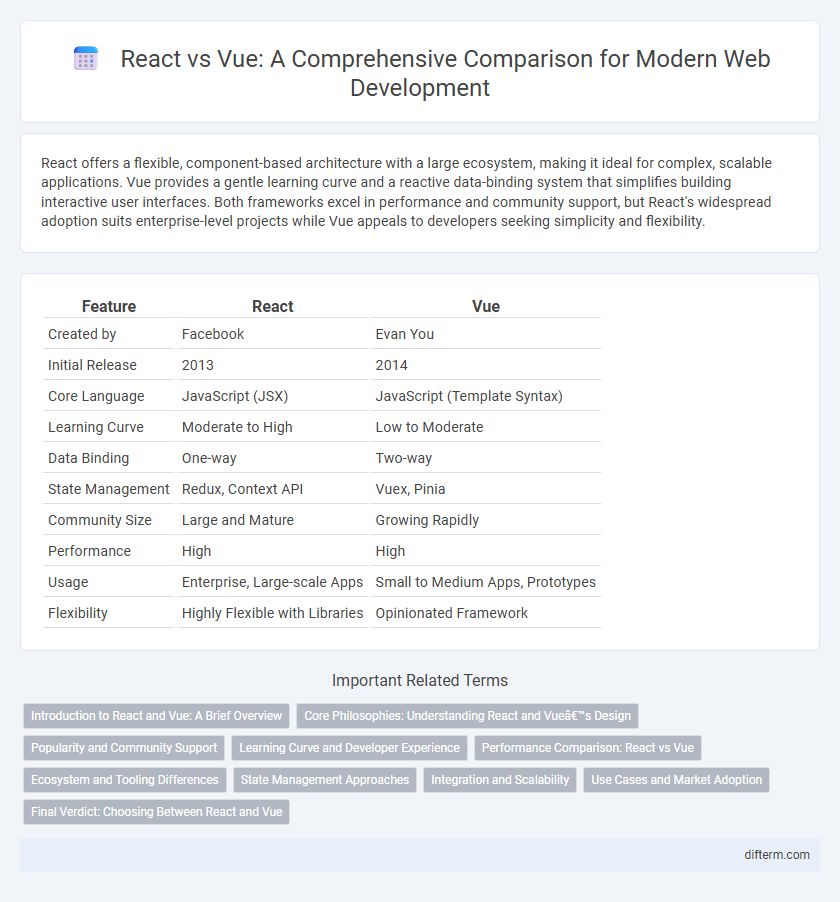React offers a flexible, component-based architecture with a large ecosystem, making it ideal for complex, scalable applications. Vue provides a gentle learning curve and a reactive data-binding system that simplifies building interactive user interfaces. Both frameworks excel in performance and community support, but React's widespread adoption suits enterprise-level projects while Vue appeals to developers seeking simplicity and flexibility.
Table of Comparison
| Feature | React | Vue |
|---|---|---|
| Created by | Evan You | |
| Initial Release | 2013 | 2014 |
| Core Language | JavaScript (JSX) | JavaScript (Template Syntax) |
| Learning Curve | Moderate to High | Low to Moderate |
| Data Binding | One-way | Two-way |
| State Management | Redux, Context API | Vuex, Pinia |
| Community Size | Large and Mature | Growing Rapidly |
| Performance | High | High |
| Usage | Enterprise, Large-scale Apps | Small to Medium Apps, Prototypes |
| Flexibility | Highly Flexible with Libraries | Opinionated Framework |
Introduction to React and Vue: A Brief Overview
React, developed by Facebook, is a powerful JavaScript library primarily focused on building user interfaces with a component-based architecture and virtual DOM for efficient rendering. Vue, created by Evan You, is a progressive framework offering a flexible structure that combines the best features of Angular and React, emphasizing ease of integration and reactive data binding. Both React and Vue support reusable components, but React's ecosystem relies heavily on external libraries, whereas Vue provides a more integrated solution, making it suitable for different project requirements.
Core Philosophies: Understanding React and Vue’s Design
React emphasizes a component-driven architecture with a virtual DOM to optimize UI rendering and prioritize declarative programming. Vue combines the best of React and Angular by integrating a reactive data binding system and a template-based syntax for enhanced flexibility and simplicity. Both frameworks focus on modularity and reactivity, yet React centers on JavaScript-centric logic while Vue offers an approachable learning curve with more opinionated tooling.
Popularity and Community Support
React dominates in popularity with over 200,000 stars on GitHub and a massive community of developers globally, driving extensive third-party libraries and resources. Vue, although smaller with approximately 210,000 stars, boasts rapidly growing adoption due to its simplicity and progressive framework design. Both ecosystems provide strong community support, but React's larger corporate backing from Facebook ensures more frequent updates and enterprise-level integration.
Learning Curve and Developer Experience
React offers a steeper learning curve due to its extensive ecosystem and reliance on JavaScript ES6+ features, which can challenge beginners but provides powerful flexibility for experienced developers. Vue boasts a gentler learning curve with its clear documentation and intuitive syntax, enabling faster onboarding and smoother developer experience for teams prioritizing rapid prototyping. Both frameworks focus on component-based architecture, but Vue's simpler state management and built-in directives contribute to a more seamless development workflow compared to React's heavier reliance on external libraries like Redux.
Performance Comparison: React vs Vue
React and Vue are both highly performant JavaScript frameworks known for efficient rendering and fast updates. React leverages a virtual DOM with fiber architecture to optimize UI rendering, providing exceptional speed in large-scale applications. Vue utilizes a reactive dependency tracking system that minimizes unnecessary re-renders, often resulting in faster initial rendering and smaller bundle sizes compared to React.
Ecosystem and Tooling Differences
React boasts a mature ecosystem with a vast selection of third-party libraries and tools, facilitating integration with various development environments and state management solutions like Redux and MobX. Vue offers a more cohesive and opinionated ecosystem, including official tools such as Vue Router for routing and Vuex for state management, ensuring seamless compatibility and streamlined development. React's flexibility appeals to developers seeking customization, while Vue's integrated tooling provides a more consistent experience out-of-the-box.
State Management Approaches
React utilizes a unidirectional data flow with state managed primarily through hooks like useState and useReducer or external libraries such as Redux and MobX for complex applications. Vue offers a more integrated approach using its reactive data binding system and Vuex for centralized state management, allowing seamless synchronization across components. Both frameworks emphasize efficient state updates, but Vue's built-in reactivity simplifies state tracking compared to React's reliance on external solutions for large-scale state management.
Integration and Scalability
React offers superior scalability due to its component-based architecture and vast ecosystem, enabling seamless integration with diverse libraries and tools for large-scale applications. Vue provides lightweight integration options and a more straightforward learning curve, making it ideal for smaller projects or when quickly adding interactive elements to existing pages. Both frameworks support modular design patterns, but React's extensive community resources and third-party support make it more adaptable for complex integrations and enterprise-level scaling.
Use Cases and Market Adoption
React dominates enterprise-level applications and large-scale projects due to its robust ecosystem, extensive community support, and seamless integration with complex state management libraries like Redux. Vue is preferred for smaller to medium-sized projects and rapid prototyping, benefiting developers with its gentle learning curve and flexible architecture. Market adoption trends show React maintaining a larger share among global developers and top tech companies, while Vue gains popularity in Asia and among startups seeking lightweight, scalable solutions.
Final Verdict: Choosing Between React and Vue
React offers a vast ecosystem and strong community support, making it ideal for large-scale applications requiring flexibility and performance. Vue provides a gentle learning curve and an intuitive API, suited for rapid development and smaller to medium-sized projects. The final choice depends on project complexity, team expertise, and long-term maintainability requirements.
React vs Vue Infographic

 difterm.com
difterm.com